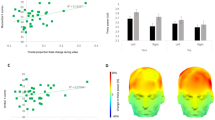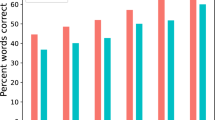Abstract
SIGNIFICANT correlations between alpha rhythm in the electroencephalogram and ratings of the temperament variable primary-secondary function have been attributed to genetically determined individual differences in a central nervous excitability characteristic1,2. Since both alpha frequency3and vocabulary score4of the Wechsler Adult Intelligence Scale were reported as positively correlated with speed of perception, it seemed possible that performance on the Wechsler Adult Intelligence Scale might be influenced by primary-secondary function. This argument was supported by the finding in 34 subjects of a significant correlation (r= 0.51, P < 0.01) between alpha frequency and total score on the Wechsler Adult Intelligence Scale. Further analysis suggested that the Scale measures non-intellective in addition to intellective aspects of intelligence, and that the former possess a number of electroencephalogram correlates5. The fact that previous studies had failed to reveal correlations between alpha rhythm and intelligence was attributed to differences between the Wechsler Adult Intelligence Scale and other intelligence tests, and also to a sampling factor, it being proposed that the emergence of electroencephalogram correlates of non-intellective components of intelligence is dependent on the intellective and socio-economic homogeneity of the sample studied5.
This is a preview of subscription content, access via your institution
Access options
Subscribe to this journal
Receive 51 print issues and online access
$199.00 per year
only $3.90 per issue
Buy this article
- Purchase on Springer Link
- Instant access to full article PDF
Prices may be subject to local taxes which are calculated during checkout
Similar content being viewed by others
References
Mundy-Castle, A. C., J. Nat. Inst. Personnel Res., 6, 95 (1956).
Mundy-Castle, A. C., J. Nat. Inst. Personnel Res., Monogr. Supp. 2 (1958).
Mundy-Castle, A. C., J. Nat. Inst. Personnel Res., 6, 38 (1955).
Livson, N., and Krech, D., J. Pers., 25, 46 (1956).
Mundy-Castle, A. C., J. Pers., 26, 184 (1958).
Bingley, T., Acta Psychiat. et Neurol., Supp., 120, 33 (1958).
Nelson, G. K., EEG Clin. Nenrophysiol., 11, 73 (1959).
Rey, J. H., Pond, D. A., and Evans, C. C., Proc. Roy. Soc. Med., 42, 17 (1949).
Author information
Authors and Affiliations
Rights and permissions
About this article
Cite this article
MUNDY-CASTLE, A., NELSON, G. Intelligence, Personality and Brain Rhythms in a Socially Isolated Community. Nature 185, 484–485 (1960). https://doi.org/10.1038/185484a0
Issue Date:
DOI: https://doi.org/10.1038/185484a0
This article is cited by
Comments
By submitting a comment you agree to abide by our Terms and Community Guidelines. If you find something abusive or that does not comply with our terms or guidelines please flag it as inappropriate.



